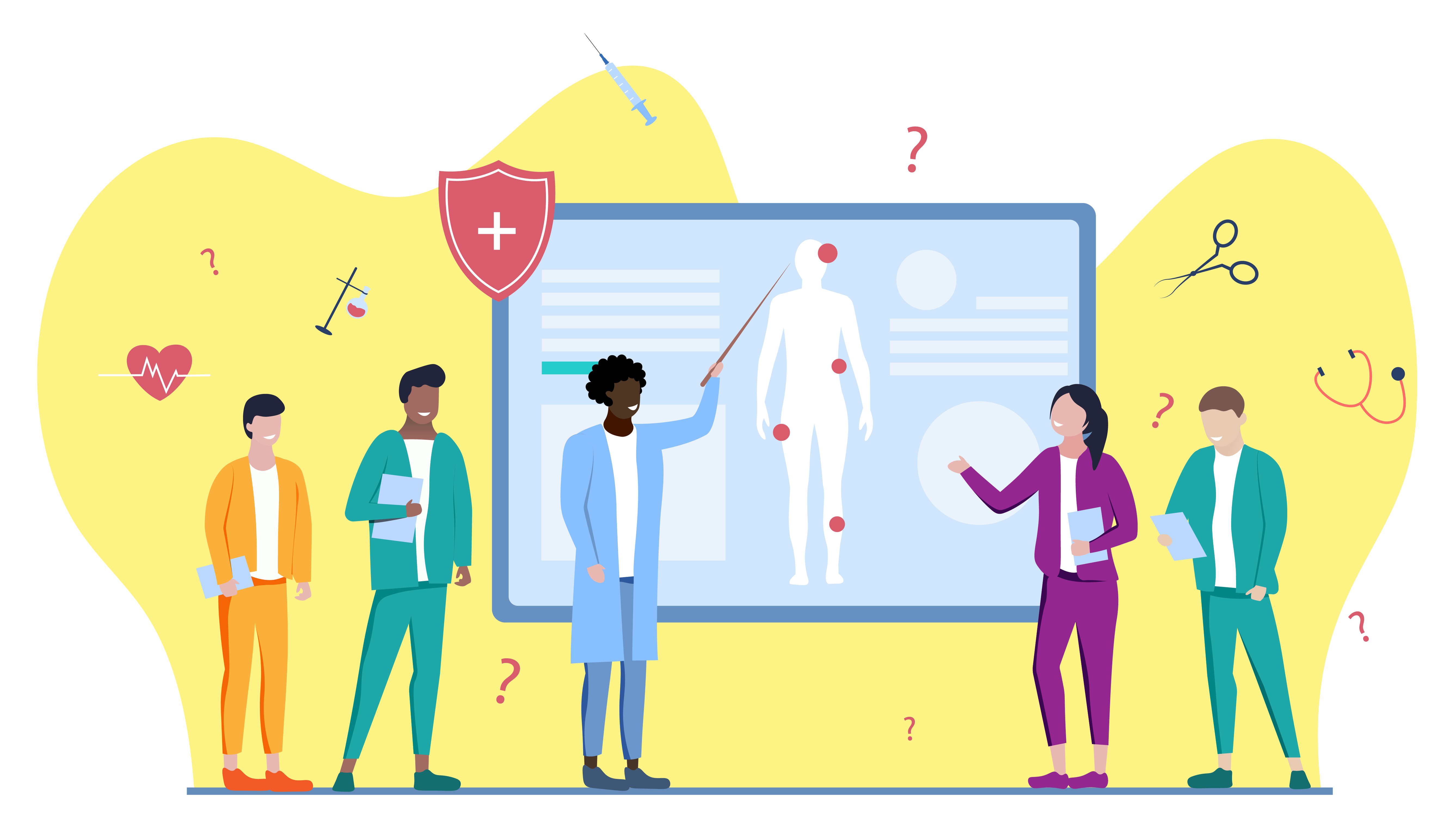
Aquifer cases are a staple assignment in many clinical rotations, but did you know that an increasing number of educators are putting them to work in the pre-clinical or pre-clerkship phase of learning for medical and health professions students?
“Incorporating more cases earlier into the curriculum would help me feel more prepared (even as an M1) to see patients in clinic and present to my attendings.”
—Third-year Medical Student
Students have noted that they see big value in using the Aquifer cases earlier in their education when they are hungry for clinical context and may be nervous about seeing real patients. Aquifer cases provide a safe space for students to practice clinical skills, understand the steps of a patient visit, and begin applying their knowledge to clinical scenarios. Faculty can take advantage of the fully-developed cases as standardized patients for providing feedback, self-paced learning, and a basis for driving discussions.
Dynamic Small Group Discussions
Applying Basic Science Concepts to Cases in an Organ-based Course
At Geisinger, Drs. Youngjin Cho, John Szarek, and their colleagues were struggling to create a meaningful replacement for an in-person simulation session during COVID-19 for an organ-based course for their second-year medical students. They found that using Aquifer cases as a base, the session on diabetic ketoacidosis (DKA) could meet the course goals and deliver an engaging and truly peer-led learning experience.
After selecting an Aquifer case on DKA that meets the session objectives–preparing students to treat DKA patients and applying basic science knowledge to clinical decision-making–Drs. Cho and Szarek break students into groups of 5-7. Students meet in a virtual format, where the group leaders bring up the Aquifer case and share their screens. The group works through the Aquifer case together, pausing for discussion whenever they want, and working together to develop a summary statement for the case. They complete the embedded questions together and are encouraged to discuss the pathophysiology of the case. The activity required no faculty facilitators, as students work in small groups led by their peers.
The session earned positive feedback from students, who noted that they were more prepared to recognize signs and symptoms of DKA, and had a better understanding of the related pathophysiology. The students found the Aquifer cases so complete that they unequivocally did not feel the need to have a faculty member serve as facilitator. The students thought they could rely on peers to encourage the identification of learning gaps and integration, with teaching points and explanations provided in Aquifer cases guiding them. At this stage (the end of their second year), they enjoyed having control of their learning and driving discussions throughout the case.
Introducing Key Clinical Concepts
At Florida Atlantic University, Dr. Mandi Sehgal integrated an Aquifer case to fuel a session for first-year students on dementia and delirium as part of the clinical skills curriculum. During a three-hour didactic, she uses Aquifer to support a modified team-based learning breakout session. In small groups, students work together to go through each component of the Aquifer Geriatrics case on Dementia. After working through the case, groups come back together to discuss the embedded questions in the Aquifer case and explore the “whys” behind the answers.
For more information, read Dr. Sehgals’ blog, “Making Connections Throughout the Curriculum.”
Near-Peer Teaching with Senior Students
Substituting Case-based Sessions for Low Patient Volume
At Northwestern, Dr. Jennifer Bierman leverages Aquifer cases to create a win-win for early learners and advanced students in the Education-Centered Medical Home program. During times of low patient volume (starting during COVID-19), her team has 3rd, and 4th-year students select an Aquifer case to teach to 2nd-year students who are rotating at the same sites. In another format, 4th-year students lead a group, which is comprised of 3rd-year students, and guide them through an Aquifer case.
“We’ve found that this kind of teaching with Aquifer really works best when the facilitator is familiar with the case. Our preceptors don’t have time to learn the cases, but the 4th-year students do, which works out very well and leads to deep discussions,” notes Dr. Bierman. “It was fantastically engaging for the 4th-year students to do this. The peer teachers were able to bring a richness to the case by sharing their personal experiences–for example, if the case is a common presentation or connecting it to a similar case they had seen– this really benefited the early learners. The activity created a sense of community among the students, as well as helping to fulfill the teaching requirements for our advanced students.”
First-year Primary Care Practicum
At the University of Washington, Karen McDonough, MD, and Jeanne Cawse Lucas, MD, brought in Aquifer cases to create an alternative activity for their first-year students’ longitudinal primary care practicum during COVID-19. The addition of Aquifer cases delivered on the course goals of focusing a history, exam, and documentation into a presentation and SOAP note.
With senior students eager to help, they were brought on board to guide learners through an Aquifer case in a 2-hour virtual session. Peer teachers screen share the case and engage learners in developing a differential diagnosis, relevant questions, and exam maneuvers. Learners independently compose summary statements, which they share for discussion via chat. Faculty note that the quality of SOAP notes improved significantly after this session, and senior students enthusiastically embraced the role of teacher. Peer teachers were supported with training on small group facilitation, feedback, and teaching scripts–and asked to reflect on their performance. For some sessions, a colleague joins them to provide focused feedback on their teaching. “Although virtual peer teaching with Aquifer was born of necessity, we plan to continue it after the pandemic. We feel that the structured SOAP note practice and opportunities for near-peer mentorship from senior students have been extremely beneficial to our community of learners and educators,” noted Dr. McDonough.
For more details on this approach, including a facilitator’s guide and list of cases, check out a blog post from our contributors, “Virtual Peer Teaching with Aquifer.”
Clinical Skills Development
Providing Feedback on Clinical Reasoning
At Case Western Reserve University Physician Assistant Program, Sara Kraus, MMS, PA-C, uses Aquifer cases as the foundation for both flipped classroom and individual learning sessions to support our pediatrics course for first-year students. They chose Aquifer cases because of the emphasis on patient counseling, expectation management, and shared decision-making in pediatric medicine. Each session includes an in-class lecture that covers the “don’t miss” diagnoses for the topic, followed by the students independently completing the associated Aquifer case- and – importantly – the Aquifer Case Analysis Tool worksheet. “We chose this approach because we are working to encourage our students to dive deep into their independent knowledge building, build confidence in their ability to approach unanswered questions, and encourage patient-centered thinking as they move closer to Clinical Year,” notes Sara.
The Case Analysis Tool worksheet goes through each step of the case, guiding students through the clinical reasoning process and asking students to explain their decisions along the way. At Case, faculty review and provide detailed feedback, which helps to support the transition from reciting facts to clinical reasoning, considering the patient perspective as they develop diagnostic and therapeutic plans, and independently navigate new situations.
For more information, read Sara Kraus’s blog, “Case Analysis Tool: Feedback for Developing Clinical Reasoning Skills.”
Teaching & Assessing SOAP Notes
At Case Western Reserve University School of Medicine, Dr. Rhona Mourad uses Aquifer to teach and evaluate pre-clinical students’ SOAP notes. Students are all assigned the same Aquifer case (or a portion of the case), and given one week to complete the case and write a SOAP note. This gives the students the opportunity to work at their own pace and develop skills before entering a busy clinical environment. Faculty provide written feedback to students with the confidence that they have the full picture and details of the encounter. This approach also provides an opportunity to expand the pool of evaluators to include faculty or advanced students since they can access the case and follow a rubric for standardized assessment.
For the full story, listen to Dr. Mourad’s podcast, “Teaching and Assessing SOAP Note Skills with Pre-clinical Students.”
Clinical Context with a “Case of the Week”
Dr. Sherilyn Smith notes that Aquifer cases make an excellent clinical correlate in basic sciences classes. She recommends assigning just one case per week (e.g. pediatric case about cystic fibrosis in a genetics course; internal medicine case about anemia in a hematology course). “Students at the University of Washington have told me that this is about the right number of cases because the case content can be complicated for early students. Students can work independently through the case and you can use it as context for discussion about how the basic science helps explain the clinical presentation–getting to the “why” behind how patients present as they do!”
Brooke Clemmensen, a third-year student from the University of Nevada, Reno, also notes a positive “case of the week” experience during her pre-clinical phase. Her cohort had a ‘case of the week’ series a few times a month that corresponded to the system they were studying. She found the addition of an Aquifer Radiology case a particularly effective complement to the week’s work. Students worked through the case asynchronously and reviewed it as part of the case wrap-up at the end of the week. “This was a nice format and good introduction to the relevant radiology studies to support the case work-up. It was particularly helpful because the case helped introduce many resources I continue to use on the wards to determine if/when a certain study is appropriate and helped begin instilling critical thinking skills around ordering imaging studies. Now that I am in my clinical year, I’m thankful I had this introduction during pre-clinical studies.”
“There are so many important topics that don’t fit neatly into a traditional physiology or pathology block–like radiology, strategy in ordering diagnostic tests, and social determinants of health– that are essential to meaningfully contributing to assessments and plans at the beginning of third year. I think introducing some of these topics through Aquifer modules in ‘case of the week’ format, or including them as an assignment during an orientation to clinical practice is a helpful approach.”
“Bring Patient Safety to Life”
Dr. Andrew Olson, at the University of Minnesota, recommends integrating the cases from Aquifer Diagnostic Excellence into pre-clerkship patient safety courses. “The topic of patient safety is an increasing focus in health professions education programs, and many schools now teach about patient safety very early in the educational journey. These cases are an excellent resource to use in these courses that bring important clinical context and simulated patient experiences that ‘bring patient safety to life’,” notes Dr. Olson. The clinical content in the cases is quite accessible to even early learners. Cases can be assigned for self-directed study, or as preparation for a flipped classroom session.
For more about Diagnostic Excellence, read Dr. Olson’s blog “Teaching About Diagnostic Error: Tools for Creating Space in a Crowded Curriculum.”
You can also watch Dr. Olson’s webinar, “Best Practices for Teaching About Diagnostic Excellence,” on demand any time on our YouTube page.
Share Your Story
Are you using Aquifer to teach pre-clinical students? Tell us more! Consider sharing your story in a blog, podcast, or webinar.




